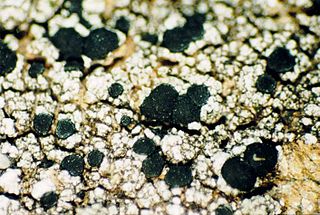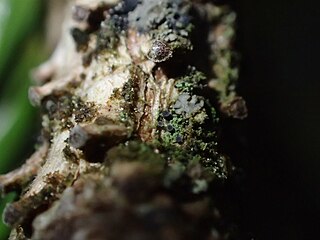
The Catillariaceae are a family of crustose lichens in the order Lecanorales. Species of this family have a widespread distribution, especially in temperate areas. The family was originally circumscribed by Austrian lichenologist Josef Hafellner in 1984.

The Lecanoraceae are a family of lichenized fungi in the order Lecanorales. Species of this family have a widespread distribution.

The Stereocaulaceae are a family of lichen-forming fungi in the order Lecanorales. It contains five genera. Species of this family are widely distributed in temperate boreal and austral regions.
Adelolecia is a genus of crustose lichens in the family Lecanoraceae. The genus was circumscribed by Hannes Hertel and Josef Hafellner in 1984. The genus was formerly classified in the family Ramalinaceae, but molecular phylogenetic analysis showed it to belong to the Lecanoraceae.

Nadvornikia is a genus of lichen-forming fungi in the family Graphidaceae. Species in the genus are corticolous (bark-dwelling) and crustose.

Szczawinskia is a genus of leaf-dwelling lichens in the family Pilocarpaceae. The genus contains five species. The genus was circumscribed by Canadian mycologist Alvin Funk in 1984, with Szczawinskia tsugae assigned as the type species.
Redonia is a genus of lichenized fungi in the family Caliciaceae. It contains the single species Redonia chilena, a squamulose lichen. The type specimen was collected in Tarapacá, Chile, where it was found growing on calcareous soil. The genus was circumscribed in 1973 by Carroll William Dodge. The genus name honours Jorge Redón Figueroa, a Chilean lichenologist who collected the type.

Carbonea is a genus of fungi in the family Lecanoraceae. Most of the species grow on lichens. The genus is widespread, and contains 20 species. Carbonea was originally circumscribed as a subgenus of Lecidea in 1967 before it was promoted to generic status in 1983.

Lecidella is a genus of crustose lichens in the family Lecanoraceae.

The Lecideaceae are a family of lichens in the order Lecideales.
Poeltiaria is a genus of lichen-forming fungi in the family Lecideaceae. It was circumscribed in 1984 by lichenologist Hannes Hertel, with Poeltiaria turgescens assigned as the type species.

Porpidia is a genus of crustose lichens in the family Lecideaceae.
Stephanocyclos is a genus of lichen-forming fungi in the family Lecideaceae. It is a monotypic genus, containing the single species Stephanocyclos henssenianus. This crustose lichen was formally described as a new species in 1983 by German lichenologist Hannes Hertel as part of a set of exsiccata. The type specimen was collected from volcanic rock found on Marion Island, one of the two Prince Edward Islands in the southern Indian Ocean. The specific epithet henssenianus honours lichenologist Aino Henssen.
Xenolecia is a genus of saxicolous (rock-dwelling) and crustose lichens in the family Lecideaceae. It has two species: X. cataractarum, and the type species, X. spadicomma. The genus was circumscribed by German lichenologist Hannes Hertel in 1987 to contain the type, a lichen known at that time only from the type locality on Wellington Island, Chile. Its range has since been expanded to include the Falkland Islands and northern Patagonia. X. cataractarum, found in Campbell Island, New Zealand was added to the genus in 2017.

Trapeliaceae is a family of lichens in the order Baeomycetales. The family contains 12 genera and about 125 species.

Schaereria is a genus of lichen-forming fungi. It is the sole genus in the family Schaereriaceae, which itself is the only family in the Schaereriales, an order in the subclass Ostropomycetidae of the class Lecanoromycetes. Most Schaereria species are crustose lichens that live on rocks. Schaereria was first proposed by Gustav Wilhelm Körber in 1855 and was later taken up by other lichenologists despite periods of disuse.

Lambiella is a genus of lichen-forming fungi in the family Xylographaceae. The genus was circumscribed by German botanist Hannes Hertel in 1984, with Lambiella psephota assigned as the type species.

Philippe Clerc is a Swiss lichenologist. A Festschrift was dedicated to him in 2020, on the occasion of his retirement from the Conservatory and Botanical Garden of the City of Geneva, where he worked from 1993 to 2020. Clerc is an authority on the beard lichens, and has had nearly 100 publications on this and other topics, such as the lichen flora of Switzerland.
Pachyascus is the sole genus in the family Pachyascaceae. It contains a single species, the lichen Pachyascus lapponicus. Both the genus and species were described as new to science in 1968 by lichenologists Josef Poelt and Hannes Hertel. P. lapponicus was originally collected from Lapland, a province in northern Sweden. The lichen has several unusual characteristics: it grows exclusively along with the rock moss Andreaea, it bears goniocyst-like parts and produces tiny apothecia that stand in the leaf axils of the moss, and it has thick asci.
Hannes Hertel is a German botanist and taxonomist and was Director of the State Herbarium in Munich, Germany 1992 - 2004. His specialist areas are the fungi and lichens.












